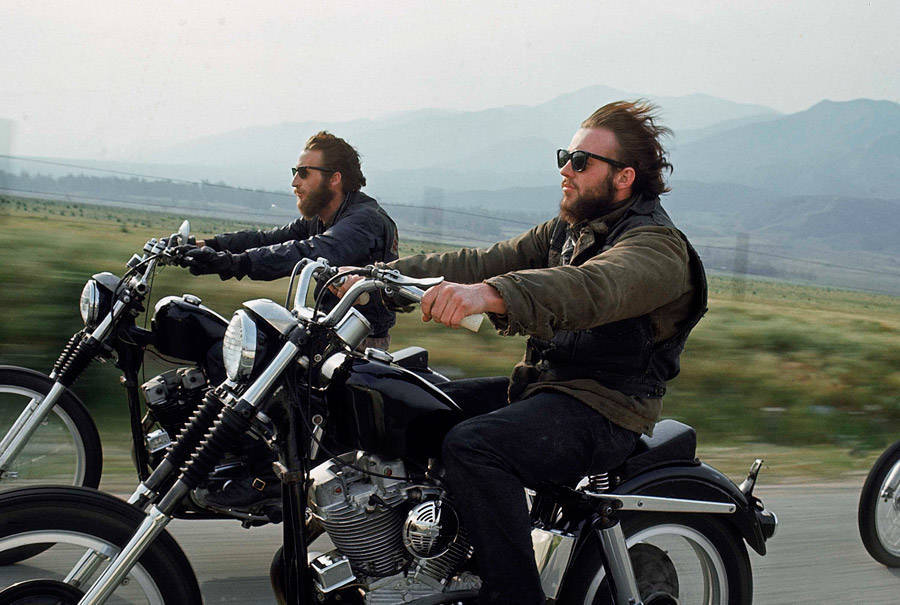Inside The Hells Angels: History, Culture, And Organization

Table of Contents
A History of the Hells Angels: From Post-War Roots to Global Infamy
The Hells Angels story is a long and complex one, marked by periods of relative quiet and explosive bursts of criminal activity and notoriety. Understanding their history is crucial to understanding the organization they are today.
The Early Years (1948-1960s):
The Hells Angels Motorcycle Club's founding in 1948 post-World War II California reflects the era's unique socio-cultural landscape. Disillusioned veterans and young men seeking camaraderie and adventure found a brotherhood in the club's early days. Their initial activities revolved around motorcycle riding, rallies, and a burgeoning sense of counter-cultural identity.
- Founding Members: The original members included Arvid Olson and Frank Sadilek, laying the groundwork for a club that would become internationally infamous.
- Early Clubhouses: These early hangouts often served as both social hubs and operational centers for the growing club.
- Early Conflicts: Territorial disputes and clashes with rival motorcycle clubs were common occurrences, setting the stage for a history marked by violence.
- Initial Public Image: While initially more focused on riding and camaraderie, the seeds of their later outlaw image were already being sown.
The Rise of the Outlaw Image (1960s-1980s):
The 1960s witnessed a significant shift in the Hells Angels' public image. Increased media attention, fueled in part by Hunter S. Thompson's iconic book Hell's Angels: The Strange and Terrible Saga of the Outlaw Motorcycle Gangs, cemented their reputation as an outlaw motorcycle gang (OMG). This period was also marked by a dramatic increase in their involvement in criminal activities.
- Hunter S. Thompson's Influence: Thompson's work, while controversial, significantly shaped public perception of the Hells Angels.
- Increased Media Coverage: The media’s focus on violence and criminal activity helped solidify the Hells Angels' outlaw image.
- Major Criminal Investigations: Law enforcement cracked down on the Hells Angels, leading to numerous arrests and convictions for various crimes.
- Expansion Across the US and Internationally: The club expanded its reach, establishing chapters across the United States and internationally, furthering their global influence.
The Hells Angels in the Modern Era (1980s-Present):
The Hells Angels continue to operate globally, maintaining a significant presence in numerous countries. While their activities have evolved, their association with criminal enterprises remains a significant aspect of their operations. Law enforcement continues to monitor and target their activities.
- International Chapters: The Hells Angels' network spans the globe, with chapters operating across continents.
- Modern Criminal Activities: Their activities today include drug trafficking, extortion, and other forms of organized crime.
- Law Enforcement Strategies: Law enforcement agencies employ various strategies to combat Hells Angels activities, including infiltration and targeted investigations.
- Ongoing Media Attention: The Hells Angels continue to attract media attention, solidifying their place in popular culture, albeit a controversial one.
Understanding Hells Angels Culture and Rituals
The Hells Angels' unique culture and rituals are central to their identity and cohesion. These aspects help maintain the group's unity and enforce its strict code of conduct.
The Patch and its Significance:
The iconic Hells Angels "Death Head" patch is more than just an emblem; it's a powerful symbol of membership, signifying loyalty, brotherhood, and a shared identity. The design and placement of the patch follow strict rules and conventions.
- The Death Head Logo: The skull logo is instantly recognizable and deeply symbolic within the club.
- Variations in Patches: There are variations in the patches depending on the member's rank and chapter.
- Significance of Colors and Lettering: Each element of the patch carries specific meaning and significance within the club's culture.
- Patch Rules and Regulations: The proper wearing and display of the patch are strictly regulated, with serious repercussions for violations.
Initiation and Membership:
Becoming a full-fledged Hells Angel is a rigorous process. Prospective members, known as "prospects," undergo a period of probationary membership, proving their loyalty and commitment before official initiation.
- Prospect Period: This period involves completing various tasks and proving their worthiness to the club.
- Initiation Ceremonies: The initiation rituals are secretive and remain largely unknown to outsiders.
- Hierarchical Structure within Chapters: The club maintains a strict hierarchy, with different ranks and responsibilities.
- Member Responsibilities: Members are expected to uphold the club's values, contribute to its activities, and maintain loyalty.
The Code and Lifestyle:
The Hells Angels operate by an unspoken code, emphasizing loyalty, respect, and absolute secrecy. This fosters a strong sense of brotherhood and community within the club.
- Loyalty: Loyalty to the club and its members is paramount.
- Respect: Respect for fellow members and the club's hierarchy is strictly enforced.
- Secrecy: Secrecy regarding club activities and internal affairs is crucial.
- Motorcycle Culture: Motorcycle riding remains a central aspect of their lifestyle and identity.
- Community within the Club: Members often develop strong bonds and a sense of belonging within the group.
The Organizational Structure of the Hells Angels
The Hells Angels are a highly organized criminal enterprise with a complex structure facilitating its global operations.
Chapter System and Hierarchy:
The Hells Angels are organized into individual chapters, each with its own leadership and territory. These chapters operate under a broader national and even international structure.
- Chapter Presidents: Each chapter is headed by a president responsible for its operations.
- Regional Leadership: Chapters are often grouped into regions, with regional leaders overseeing multiple chapters.
- National/International Leadership: A national or international governing body coordinates activities across chapters.
- Communication Channels: The club uses various communication channels to maintain contact and coordination across its network.
Maintaining Control and Discipline:
The Hells Angels maintain internal order and discipline through a strict hierarchy and a system of internal sanctions for rule violations.
- Internal Disciplinary Actions: Consequences for violating club rules can range from fines to expulsion.
- Conflict Resolution within Chapters: Internal disputes are typically resolved within the club's structure.
- Enforcement of Rules and Regulations: The club strictly enforces its rules and regulations to maintain control and discipline.
Global Operations and Networking:
The Hells Angels' global network facilitates their criminal activities and allows for efficient communication and collaboration between chapters.
- International Communication: Communication channels enable efficient coordination across borders.
- Support Between Chapters: Chapters often support each other in various activities, including criminal enterprises.
- Collaboration on Criminal Activities: The network facilitates cooperation in planning and executing criminal activities.
- Global Expansion Strategies: The club continues to explore opportunities for expansion into new territories.
Conclusion
This exploration into the Hells Angels has revealed a complex organization with a rich, albeit controversial, history. From their post-war origins to their global presence today, the Hells Angels have captivated and repelled in equal measure. Their intricate culture, rituals, and hierarchical structure contribute to their enduring, if often feared, legacy. Understanding the Hells Angels requires a nuanced approach, appreciating both their motorcycle club identity and their involvement in criminal activities. To delve deeper into this fascinating and complex subject, further research into specific historical events and individual chapters is recommended. Continue your exploration of the Hells Angels—uncover more of their story.

Featured Posts
-
 Van Der Poels Dominant Tour Of Flanders Performance Pogacars Contention
May 26, 2025
Van Der Poels Dominant Tour Of Flanders Performance Pogacars Contention
May 26, 2025 -
 Atletico Madrid Sevilla Yi 2 1 Yendi Mac Oezeti Ve Analiz
May 26, 2025
Atletico Madrid Sevilla Yi 2 1 Yendi Mac Oezeti Ve Analiz
May 26, 2025 -
 David Hockney A Bigger Picture A Retrospective On His Yorkshire Landscapes
May 26, 2025
David Hockney A Bigger Picture A Retrospective On His Yorkshire Landscapes
May 26, 2025 -
 Naomi Kempbell I Ee Deti Foto Syna I Docheri
May 26, 2025
Naomi Kempbell I Ee Deti Foto Syna I Docheri
May 26, 2025 -
 Laviolette Out New York Rangers Part Ways With Coach
May 26, 2025
Laviolette Out New York Rangers Part Ways With Coach
May 26, 2025
Latest Posts
-
 Nba Playoffs Tyrese Haliburton Props And Best Bets For Game 3 Knicks Vs Pacers
May 28, 2025
Nba Playoffs Tyrese Haliburton Props And Best Bets For Game 3 Knicks Vs Pacers
May 28, 2025 -
 Tyrese Haliburton Performance Game 3 Knicks Vs Pacers Betting Analysis
May 28, 2025
Tyrese Haliburton Performance Game 3 Knicks Vs Pacers Betting Analysis
May 28, 2025 -
 Knicks Vs Pacers Game 3 Tyrese Haliburton Prop Bets And Predictions
May 28, 2025
Knicks Vs Pacers Game 3 Tyrese Haliburton Prop Bets And Predictions
May 28, 2025 -
 Tyrese Haliburton Picks Knicks Vs Pacers Game 3 Predictions And Best Bets
May 28, 2025
Tyrese Haliburton Picks Knicks Vs Pacers Game 3 Predictions And Best Bets
May 28, 2025 -
 Smartphone Samsung Galaxy S25 Ultra 1 To Le Meilleur Prix Garanti
May 28, 2025
Smartphone Samsung Galaxy S25 Ultra 1 To Le Meilleur Prix Garanti
May 28, 2025
